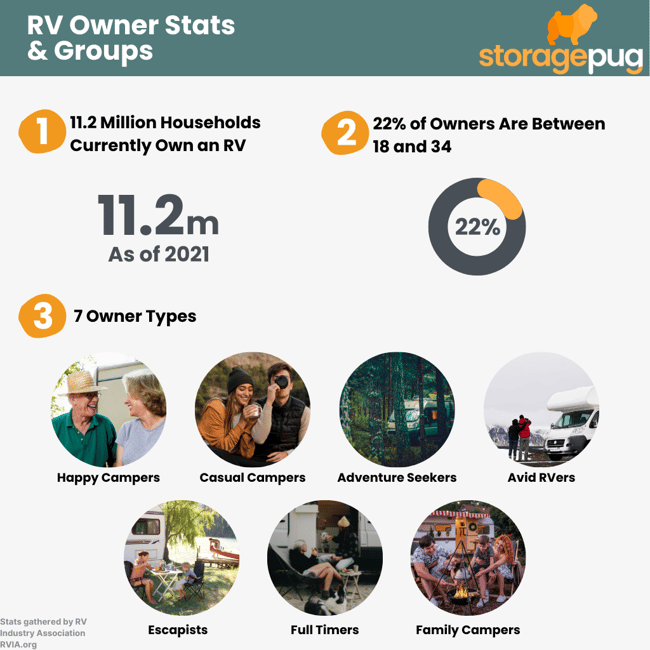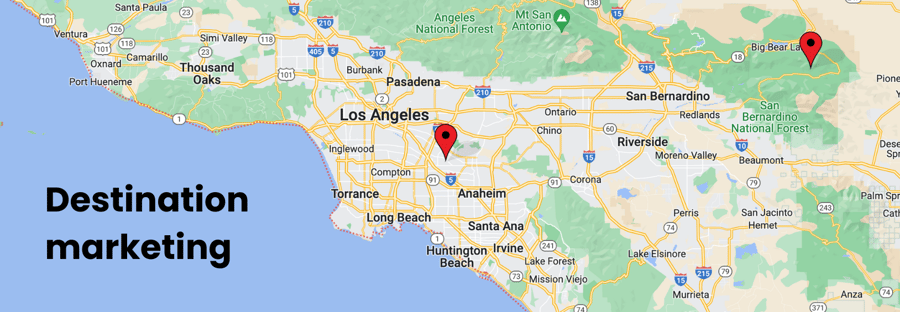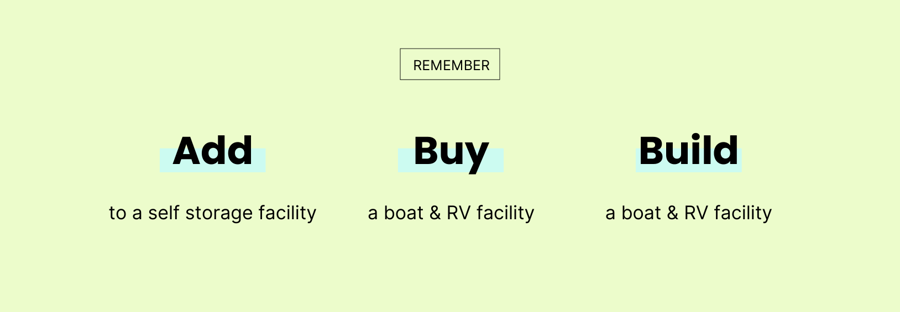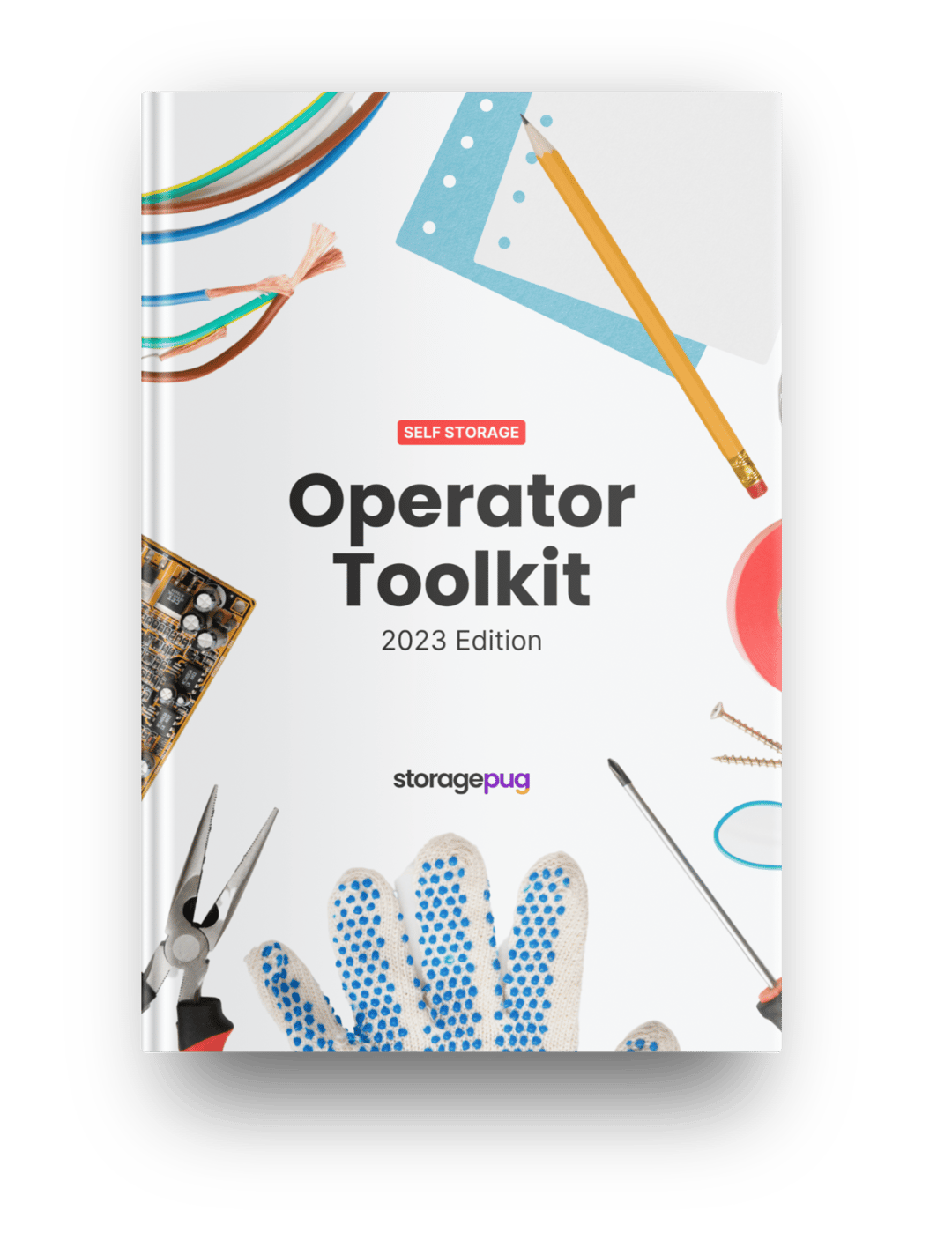Menu
May 16, 2025


Is boat and RV storage a good investment? Should you buy it, build it, or add it to an existing self storage property?
Boat and RV storage—or, more simply, vehicle storage—is nothing new to self storage operators.
It’s not uncommon to see a self storage facility with parking available for boats, RVs, cars, trailers, and other types of vehicles. In some cases, you can even allow customers to store vehicles inside actual storage units. In most cases, it’s an open lot that may or may not be paved.
If you’re looking at getting into the vehicle storage world, though, there are a number of considerations to keep in mind. Boat storage and RV parking are different animals than the typical self storage facility. Customers and their expectations are different, and that can change the entire way you approach the business.
Here’s the good news: We’re here to help you better understand the nature of vehicle storage.
Demand for recreational vehicle storage is on the rise.
Unlike self storage, where demand is impacted by a wide range of factors, boat and RV storage demand has only a few major factors to consider. The most obvious of those factors is how many people own boats and RVs. As it turns out, that number is still on the rise—and the available storage doesn’t currently accommodate it:
So, what does this mean?

It means that there is a lot of room to build out boat and RV storage to answer the demand. By those numbers, if we took every single facility offering vehicle storage and tried to divide the existing market among them, each facility would need to house over 2,000 vehicles.
So to state that again, the current demand far surpasses supply.
We can combine these statistics with the fact that many HOAs and municipalities have started to push boats and RVs out of homes and to storage facilities. In the past, you might have seen more people storing their recreational vehicles at home. Today, that is increasingly difficult , meaning even people who did not traditionally seek out storage facilities could be forced to do so depending on where they reside.
These numbers look great, but will they stick? Will demand continue to rise, or will it go on a decline?
When it comes to boat and RV storage, the items being stored are less likely to be offloaded to a dump when the owner is done with them. Someone might toss out their old couch once it’s too ratty to sell. All of those boxes of old knick-knacks could go right into the trash one day.

As for RVs and boats, these vehicles are much more likely to stick around. Rather than trashing an RV, you’re more likely to sell it. Sure, even vehicles reach the end of their lifecycle, but it’s not nearly as easy or as common to toss them when you’re done with them. This means that there’s a chance that demand remains despite market factors such as RV sales.
Combine this with the fact that new boats and RVs are still being manufactured and purchased, and this means the demand would continue to grow consistently so long as more of the vehicles are purchased each year than are terminally junked.
In this scenario, demand is going to stay steady, if not increase, year-over-year, for the foreseeable future. And that’s on top of the already underserved market.
Boat and RV customers are very different than the typical traditional self storage customer.
The difference in the customers between both types of facilities leads to different expectations and, as a result, a different approach to the business. It’s important to know your customers when deciding how to build or buy—or whether you want to build or buy in the first place.
If you’re considering getting in on vehicle storage, keep the following in mind when looking at your options:
The nature of boat and RV storage is so different than self storage because of the expectations of customers and because of the reasons they seek out storage to begin with.
In traditional self storage, you’ve probably heard the old wisdom that customers seek out storage largely due to big life events. Many of these life events are unfortunate and unexpected. Death, disaster, and the other two or three D’s (depending on who you ask). There can also be other reasons that are less sad—you just have too many things and not enough space, you’re moving for happy reasons, and so forth.
When it comes to storing boats and RVs, customers are more likely to be on the upswing in their lives. They’re financially stable enough to have made a huge, expensive vehicle purchase just for fun.

The RV Industry Association (RVIA) places RV owners into seven categories based on their motivations and frequency of use. These categories range from casual campers to full-time lifestyle campers. If you get into RV storage, you may benefit from learning about your different customers to that level.
When planning your entry into the industry, though, there are a few things about your customers that are most important to consider:
Security, amenities, construction, and self storage marketing are all going to change when you take these different types of customers and expectations into mind.
Knowing your customer is your first step in knowing how to build your facility. It’s also important to note that not every customer is the same. While many might look for a luxury executive-class facility, there are others who may be happy with the bare minimum to save money.
Once you know exactly what market you’re trying to target, it’s time to figure out exactly what you’re building.
Here are some questions surrounding facility construction:
Now, some of these questions may be influenced by what type of boat and RV storage you’re trying to offer. If you’re expanding an existing self storage facility to offer boat and RV, you probably don’t want to go all-in on executive-level vehicle storage amenities. Meanwhile, building a top-of-the-line luxury boat and RV storage facility means your construction decisions should prioritize wowing the customer.
These decisions should also account for the willingness of boat and RV owners to travel for storage.
Unlike traditional self storage, where customers look within a few miles of home or work for storage, boat and RV storage customers will often seek to store closer to their destinations and are willing to travel further to do so. With this in mind, having the right amenities and a good layout for your facility could create major advantages over competitors in a market where proximity is a little bit less important than self storage.
So, if you offer dump stations, dog parks, and trickle chargers? Make sure that’s obvious in your marketing efforts.
If the customer is different, you can bet that means marketing a boat and RV storage facility will also be a little bit different than marketing a traditional storage facility.
Outside of the obvious—such as prioritizing the amenities your customers care about most—there are three main areas to pay close attention to when it comes to vehicle storage marketing:

The boat and RV facility marketing radius is much larger than in traditional self storage.
This comes from the fact that customers will travel further to find the right facility for their needs. According to some sources, people might travel as far as fifty miles from their home or destination to find what they are looking for.
This radius will also depend on the type of customer you’re attracting, of course. A customer who lives in proximity to multiple fishing spots will probably still prioritize storing close to home. Meanwhile, a class-A RV owner will likely be willing to travel much further if the storage facilities near home don’t offer the amenities, security, and other features they want.
This has important implications for your website’s SEO and digital ad campaigns.
For digital ads especially, you’ll want to make sure you are targeting a broader geographic region for your audience compared to traditional self storage.

Destination marketing refers to marketing your business to potential customers that intend to travel to a destination.
This is a little bit different than local marketing. While you’re still focusing your SEO and other marketing-related efforts on a local area, you’re not specifically targeting locals and people searching from nearby. Your target audience could be many states and hours away from your business.
For example, say you run an RV storage facility near the Grand Canyon. The Grand Canyon has RV campsites. Due to the cost of gas and many other travel-related expenses, it’s highly likely that some RV owners who frequent the Grand Canyon would prefer to store their RV nearby. You may have customers as far-flung as Maine (for even further).
In light of this, some of your marketing efforts should go towards attracting these customers.

Word-of-mouth marketing is part of any business, including self storage. But for boat and RV storage, it is a little bit more impactful.
Your boat and RV customers are the owners of leisure vehicles. These customers have friends who also own boats and RVs, they join social groups with other owners of boats and RVs, and they talk. In self storage, it’s possible for someone to go for most of their life and never really discuss their storage unit with a friend or family member. Even if they do, it hardly matters for the facility unless that friend or family member also needs a storage unit.
In contrast, it’s highly likely that boat and RV owners will talk about where they store at some point in time with other owners.
Work hard to form a relationship with them, especially if they are long-term tenants. If you can't build a relationship with your tenants, then go out into your community and build a relationship with other businesses, especially those that could help your customers.
For example, you can build a relationship with the repair shop down the street that often repairs boats and RVs. You can give out your cards to your local boat and RV dealer. These people can not only help your customers, but they can help you as well.
Building a healthy relationship with customers and those in your community is a great way to increase word-of-mouth marketing and get the referrals you need.
Just like with traditional self storage facilities, starting a vehicle storage facility is a major undertaking.
There are also many ways to tackle getting into the industry. It could be as simple as turning unused land at an existing storage facility into boat and RV parking, or it could be as complicated as purchasing new land and building a facility from the ground up.
Each method has its pros and cons.

If you already own a self storage facility, adding vehicle storage seems like a no-brainer!
This is a way to take space you’re not using and turn it into a revenue-generating addition. If you choose to go with open parking or just a covered lot, it’s even easier than having to construct additional storage units.
You’re not likely to attract high-end executive-class luxury RV owners with this kind of setup. Instead, you should consider focusing your marketing efforts on local casual RV and boat owners.
In self storage, buying an existing facility and improving it to raise rates, increase occupancy, and turn a profit is standard practice.
This is possible with boat and RV storage, too. The benefit is that the facility is already there, and you may just need to make some adjustments to bring it up to the performance you desire. It may even be things like the facility’s marketing efforts and operational systems that need updating instead of the physical property.
What is the downside to buying a vehicle storage facility? Well, we’ve already talked about how underserved the boat and RV storage market is. That means there are very few facilities available to purchase.
You may have an easier time finding the land and building a facility yourself. This brings us to…
It should come as no surprise that building a facility from the ground up allows more flexibility.
The upside to this is that you can make it whatever you want it to be! Barebones storage for locals? A small but cozy facility for casual travelers? An executive facility for luxury owners? Anything is on the table when you’re building from scratch.
The hardest part of building, of course, is that you need to design the facility from scratch, too. You also need to find the right land. These days, many municipalities are making it harder and harder to get new storage facilities approved. This is the same for vehicle storage, so you may need to build on the outskirts of the municipality. Making sure to verify the zoning and use of your chosen parcel of land is critical.
One more bright side to a new build is that it is generally easier to do in boat and RV storage compared to traditional self storage. In fact, you don’t even need to worry about building to get started. Once you have the land, you can set it up as an uncovered vehicle storage facility and start your business that way.
You can then borrow against that business, giving you more capital to expand your facility and turn it into whatever you wanted from the start!
This is a big question you need to ask yourself before starting any endeavor.
Different people will give different advice on the profitability of boat and RV storage. Some people think that it brings in a smaller return per square foot of storage. Others think that the demand and possibility to lean into higher-paying luxury markets bring in a much higher return than self storage units.
The answer to this question can also differ depending on your market. While it may be profitable in one market, it may not be as profitable in another. For example, Minneapolis and Kansas City saw vehicle storage rates rise in 2024 while the national average declined.
What percentage of that could your boat and RV storage facility make? Unfortunately, that's a question I can't answer. You will most likely need the help of internal staff or financial consultants to find that information.
Before starting any project, always look into feasibility studies, cap rates, and other market and industry statistics relating to your specific plan.
By now, you can probably gather there is a lot of potential in the boat and RV industry.
Potential doesn’t mean it’s the right move to make, though. And it could even be the right move for some people but not for you. Just like in traditional self storage, there are many avenues to consider.
While the profitability of boat and RV storage may be up for debate, the demand for it seems to be there. According to the RV Industry Association, RV ownership has increased by over 62% in the last 20 years with a record 11.2 million RV-owning households. Plus, the age of RV and boat owners is decreasing year by year as Millennials and Gen Zers enter the market. It’s a different business than self storage in many cases, though, and you should know what you’re getting into before you choose to dive in just because of the demand.
If you are thinking about entering the industry, here are some key questions for you to answer to help decide if it’s the right move for you:
If you aren't sold on the boat and RV market, you can still inch into large vehicle storage with a different kind of vehicle. Commercial vehicles are commonly used by small and large businesses alike. Professionals like carpenters, contractors, and retailers are just a few examples of people who may use commercial vehicles.
And don't worry, this doesn't necessarily include semi-trucks. While semis are commercial vehicles, it can be difficult to store them as they are some of the largest vehicles on the road.

However, there are other commercial vehicles that take up a lot less space. Light commercial vehicles are classified as weighing less than 3.5 metric tons (a semi is usually more than 15 metric tons). This can include the van that your plumber shows up in or the utility truck that a city electrician may use. These are the most commonly produced commercial vehicles, with roughly 11.16 million expected to sell in 2024 according to Statista.
With all of this vehicle production, buyers will need somewhere to store them!
Although this could be a great market to branch into - just like boats and RVs - you should take the time to consider the current market, associated costs, and profitability before leaping into vehicle storage.
Here are some of our other favorite posts:
At StoragePug, we build self storage websites that make it easy for new customers to find you and easy for them to rent from you.
